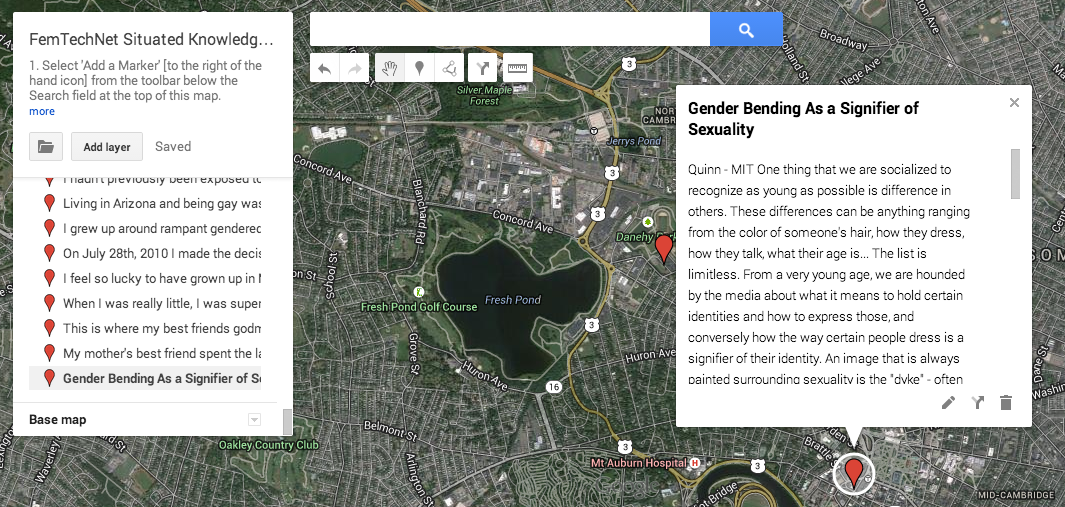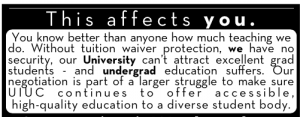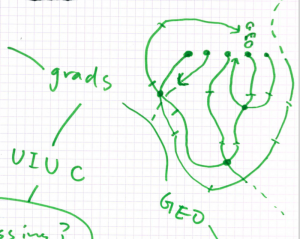Dani Pavlic, Ann Wu and Fabian Prieto
On a cold afternoon, at Dani’s studio, we talked about the previous projects that we’ve reviewed in class, the ones we are working on, and the ones that we can imagine. Our conversation started flowing as we mentioned the projects we’ve reviewed in class, and how our research interests related to these projects. We also shared our insights of what we had in mind in terms of this extra-textual project, and we started with discussions on form. We felt that we didn’t exactly have a concrete topic, but as artists we often function better with the material limitations set out in front of us. This discussion of form acted as a springboard for project ideas, and we documented them here.
“Standing with” and “speaking as”
Kim Tallbear’s discussion on conducting participatory research from the standpoint of speaking as and standing with the population that we are researching, or that we are researching together, resonated strongly with us. Instead of imagining creating a system, platform, pedagogy, or interface that acted as “giving back” or “doing for,” we are going to facilitate democratic knowledge production. It is not that we completely reject hierarchy, but rather we are interested in creating self-sustaining systems that allow for situated knowledge to arise and spread. Participatory in the sense of collective inquiry and sharing.
Various existing projects exemplifies this idea of participatory practices as democratic knowledge production. FemTechNet has created a situated knowledge map that facilitates the documentation of memories related to our gender socialization. It kind of acts like a Wikipedia, where anyone from anywhere can add to this existing body of knowledge by providing the bits and pieces that you know. But instead of expecting the participants to act objectively and neutrally, this Feminist knowledge map encourages experiences that are personal and in ways subjective. The theoretical framework of Situated Knowledges rejects the understanding that there can be an objective position to stand, and that all of our interaction is filtered and biased in ways that shape our subjectivity. Only after recognizing and embracing this condition, we can move forward in any intellectual inquiry.

Thus, how can we create a system that enable us to speak as a collective but recognize our different positionalities and subjectivities? We considered this question as one key aspect of our discussion about form. Operating under this condition, we imagine our project to be a way to facilitate the unraveling of digital stories. Digital in the sense that it is mediated through computational structures, and stories in the sense that is subjective and personal. As individuals who participate in the project are coming in with a series of stories already woven with other individuals’ stories, this project aims to start a new story thread that unravel this complicated relationship.
This affects you
We discussed how the audience/participants are important in developing the form of this project. We concluded graduate students could be our potential audience/participants. It was important for to realize the scope of the project terms of development, and considered local stories within our community here at UIUC. We have all had the experience of trying something new in a new place, with no strong affiliations with either the community or the location, which was a recipe for failure. With all of this in mind, our idea is to affiliate this project with the GEO, and initially target this project for graduate students. Julia Flanders address the various positions of labor within Universities that are not faculty positions. This aspect is important to be aware of as we begin to locate this project within a single division of the labor. We discussed the possibility of this project being something that starts at with the graduate union and can slowly be woven into other student bodies and position of labor within UIUC.
Flanders addressed in her essay how she spent her time as a graduate student. She remarks on how the role of the University in overlapping her professional and personal spaces. This idea is interesting to me in having had experienced a similar situation, where the expectations of me professionally were not contained in terms of time and space. I bring this up because, as a group, we discussed the potential for this project to address this academic/personal space through the means of shared/ongoing stories.
Measuring qualitative and quantitative scholarly work, is an issue Flanders addresses, an issue that we indirectly discussed in our meeting. She describes how the evaluation of quantifying scholarly work is built into the framework of the University. The project we are proposing would possibly facilitate a discussion that would assist in the production of quality scholarship.
How to platform such ideas?
We considered how “institutional” could be our project. Will be use orange and blue? Will be address images of our diversity? Will we write it in HTML? After reading Johanna Drucker text, I reinterpreted some of our first approaches to design. I believe that we agree in how the materiality of any interface could encourage the performative act of interpretation. However, our achievements are modest. We don’t look for a perfect semiotic machine, with the only politics of been interpreted by any subject (by the way a cultivated subject).
Our starting point conceives this deconstruction of dominant histories of design for creating new conditions for new histories embedded in interfaces. To translate, as Laura Marks stresses, the knowledges of the body, including the unrecordable memories of the senses. We already discuss “ imperfect cinema”, hacking practices, nonproductive platforms.
Our interface will be informed by a work that evoke memories both individual and cultural. We want to consider an appeal to “non-visual knowledge, embodied knowledge, and experiences of the senses, such as touch, smell, and taste” in a dialog with the visual tools and objects for promoting narration. Be want to materialize reciprocity in these travel objects. Caring will be the performative act that our interface will encourage. Our notions of communication, especially if we think of a Mail Art project, will derive from metaphors of weaving and its roots on solidarity and communication.





